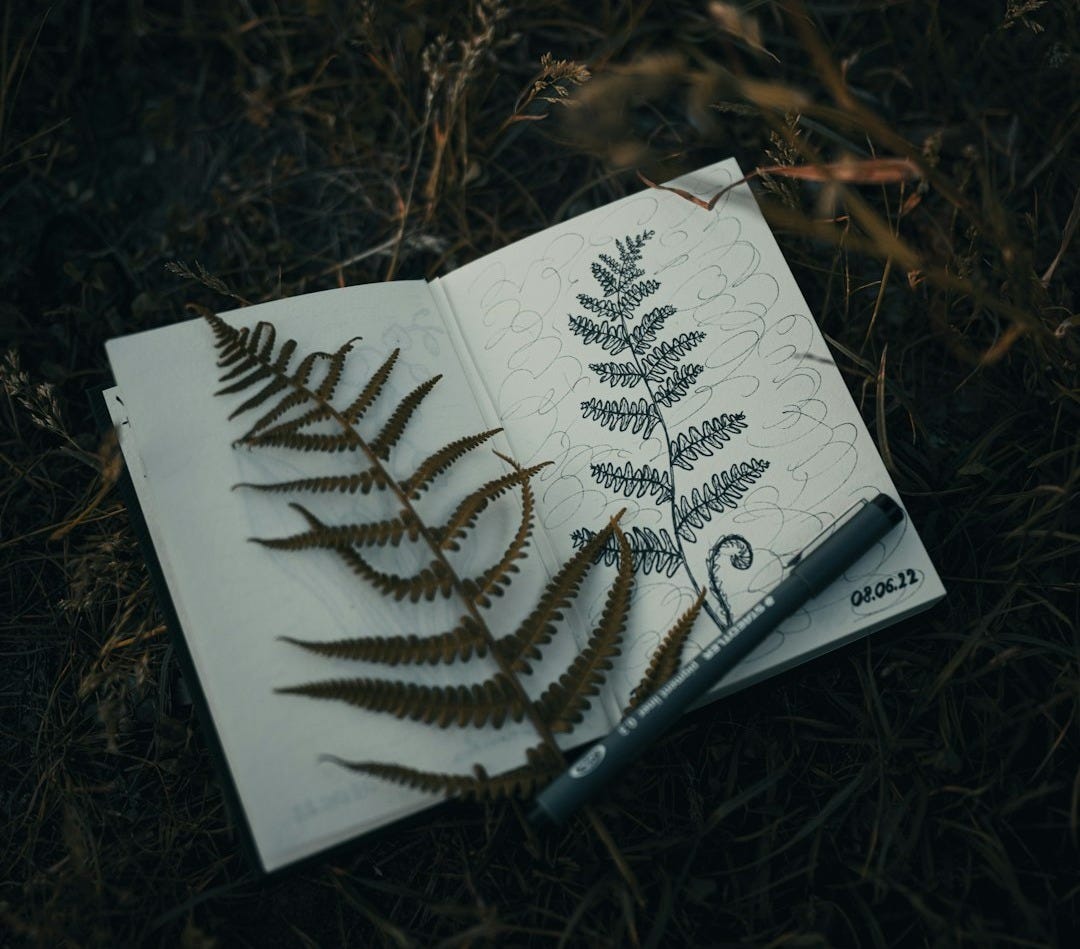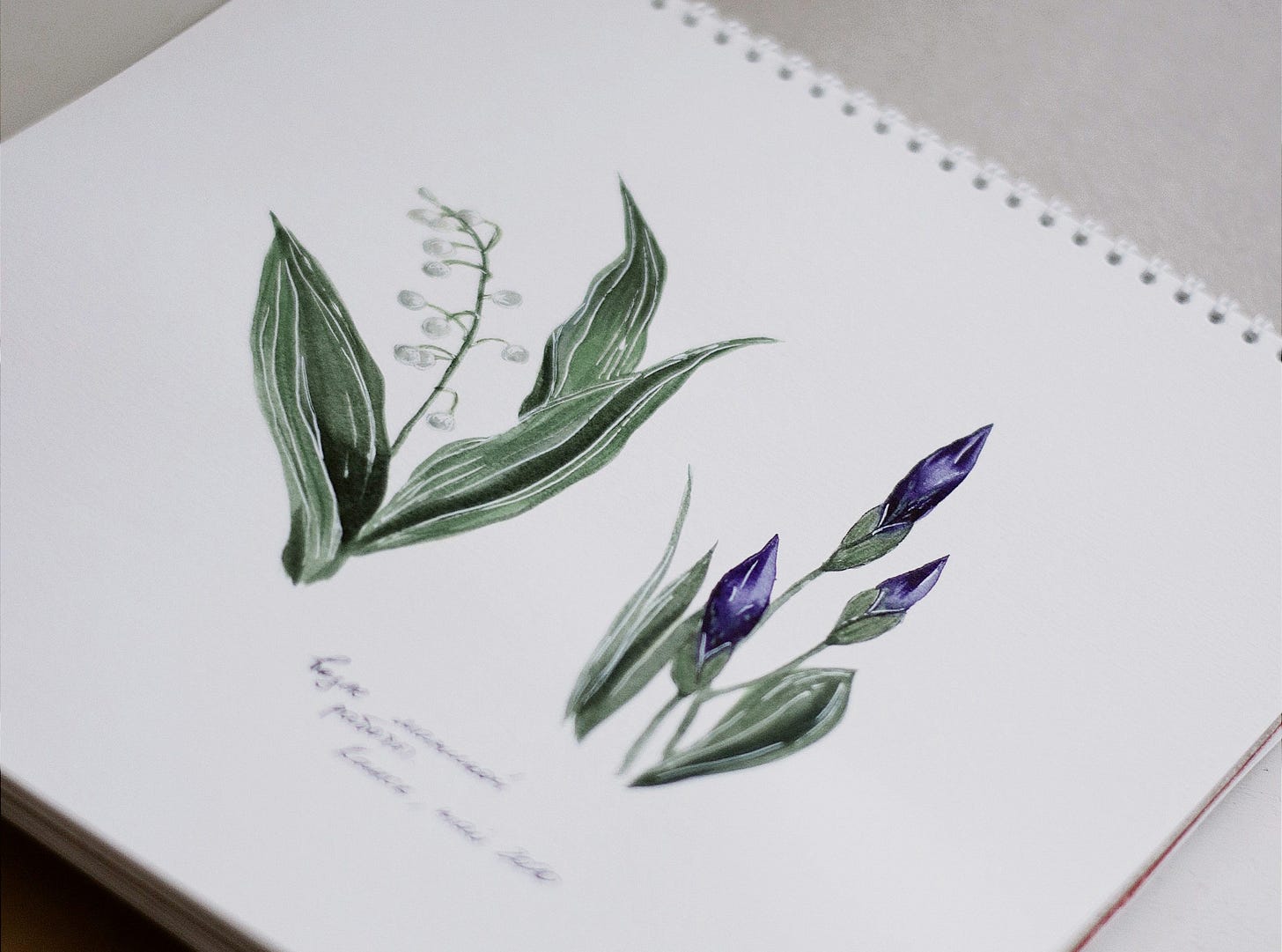Personal Curriculum: Beginning a Nature Journal
Small steps that make the practice approachable and how slowing down with a notebook changes the way you see the outdoors

“Those trees are the tallest I’ve ever seen!” shouted Scott looking up and nearly falling over. He grabbed my hand to steady himself and leaned against my leg.
“Collect all the golden and red ones!” Mary said scurrying around gathering leaves. I helped Lara out of the stroller so she could toddle around with them.
It was mid-fall in the Arizona desert and the weather had cooled off but the trees hadn’t changed yet. I wanted the kids to experience actual fall colors so we decided to pack up a lunch and head to Boyce Thompson Arboretum.
This beautiful nature spot is only a 45 minute drive out of the Phoenix suburbs but it feels like a different place. There the trees are bigger than anything around our city and the creek that runs through it makes it an oasis in the dry climate.
I decided to get out my nature notebook while the kids explored the area around me. I sat on a bench with my sketchbook balanced on my knees drawing one of the vibrant red leaves the girls had gathered.
My breathing slowed, I focused on the detail of the veins and petiole. I held it up to the light noticing finer details that I did not see before.
I looked around at the trees above to decipher which one it came from then made some notes next to my drawings.

All the while my kids were joyfully running around in our peaceful spot. It felt like we had the whole place to ourselves. I let the excitement of being outside and having no set agenda relax me.
It felt like lately the only time I spent outside was with the intention of fast-paced exercise or getting to the end of a hiking trail. Sitting on this bench drawing in my sketchbook felt like a wonderful luxury.
.
That moment (over 10 years ago) filled with peace, observation, and discovery, stayed with me and sparked countless adventures.
Nature study has been a defining highlight of my life over the years.
Through frequent nature study, I have learned more about the Sonoran desert (where I live), I am able to spot subtle changes in the seasons, and I know the sounds of most local birds.
My sketchbook and digital photo folder have gotten me through times of grief, major change, and it has broken up the monotony of adulting tasks.
Let’s walk through some details of this practice together.
frottage & outlines
A favorite technique is often referred to as frottage (a French art term that means rubbing), but in the context of nature study, most people simply call it leaf rubbing. {I just couldn’t resist being a fancy word nerd!🤓}
🌿How to Make a Leaf Rubbing:
Choose a leaf that’s not too dry or brittle; the veins should be raised enough to feel.
Place it vein-side up on a flat surface and lay a thin sheet of paper over the top.
Hold the paper steady with one hand so it doesn’t slip.
Use the side of your pencil or crayon and gently rub across the surface. The outline and details of the leaf will begin to appear.
Experiment with colors or layer several leaves on one page to make a collage.
- - - - - - - - - - -
Outlining means placing the nature item on a page and tracing around the outside edge with a pencil or pen.
It’s a quick way to capture their shape without needing to draw every detail. You can also add a few simple lines for veins or petals, then jot notes about where and when you found them. {no fancy terms for this one 😋}
🪻 Flower Sketching
Look closely at the shape of the flower and lightly sketch its outline: petals, stem, and leaves.
Add simple details like the petal lines, center, or texture without worrying about perfection.
Write a quick note nearby, like the flower’s color, where you found it, or what caught your attention.
- - - - - - - - - - -
🍂 Quick Leaf Outlining
Place a leaf on your page and trace around its edges with a pencil or pen.
Add the main veins by drawing a line down the center and smaller lines branching out.
Jot a quick note beside your outline, the tree or plant name (if you know it), the date, or something you noticed about where it was growing.

draw & sketch
“The attempt to paint (or draw) the twig, leaf, flower and fruit of every well-known tree makes us wonder whether we know them at all…” - A.C. Duruy*
It is in that moment when we put pencil (or fine point pen) to paper that we make closer observations than before. We suddenly notice lines and texture that wasn’t seen in our first glance.
Is the stick actually straight or is there a crook at the end?
Does the leaf have bite marks from a caterpillar or did it rip?
The process of drawing and sketching focuses attention to the subject. It is a moment of full presence and awareness that feels calming. The child-like wonder is centering.
I can tell you from experience that I know more about the plants I have drawn than those I have just seen in field guide pages full of facts or in photos. There is an intimacy that happens when I have to create a version of the original in my own way.

Latin names & botanical terms
“Scientific names as well as botanical terms are the shortest way of stating facts and help us condense our notes. …for these names show relationship for classification where English names cannot.”- A.C. Duruy*
Maybe it is my inner nerdy academic, but I really enjoy adding botanical terms to my sketchbook. My grandfather was a linguistics professor. I learned Greek root words at an early age and dinner conversation at his house often included a linguistic lesson.
I’m not an expert even in the slightest. I still have much to learn about classification, botany, and Latin. However, I enjoy uncovering connections and adding scientific names and notes to my simple drawings.
If this lights you up and interests you, try adding it in.
If the idea of this immediately feels in your gut like it’s too much, pretentious, or obnoxious, then please skip it!
Personal learning is all about joy and while it can stretch us it should feel authentic to who we are.

show up imperfectly & often
The power of nature study is in the frequency of the practice. Not in how perfect each drawing is or the exact location of each outing.
With frequent careful observation you (and those with you) will notice more detail and specific changes.
Going to the same spot throughout the year will reveal seasonal changes and a variety of plants and animals. You will notice birds that have migrated and insects that are more active. Watching the same tree over the course of a year will teach you about it’s life cycle and yearly rhythms.
Bring a simple notebook and make stick figure sketches, or take photos so you can sketch at home. You don’t need to start out bringing a whole watercolor pallet or charcoal set.
Just show up with what you have and make notes of what you are observing.
Action Step: Which of these feels easy to try out this week?
If this has been helpful, check out my book: Subtle Resistance
It’s full of practical ideas to make space for personal growth.
.
With all areas of life-long learning there will be seasons that are full of consistent progress and then times when the activity gets set aside and forgotten.
Nature Study is like that for me. But I know that it is a kind companion that I can come back to with joy and without judgement.
Every page you fill in a notebook becomes part of your own unique story.
I hope you try it out in some small way this week. (Even just a sketch on a napkin or back of an envelope!)
I would love to hear about your experiences. 😁 Please share in the comments what is working for you and what you hope to try.
🍄🟫🌿 Happy Nature Journaling!
.
*note: Quotes from A.C. Duruy are from the Charlotte Mason Parents’ Review article: How To Keep a Nature Notebook
![April Edwards [Embracing Home]](https://substackcdn.com/image/fetch/$s_!LQC-!,w_80,h_80,c_fill,f_auto,q_auto:good,fl_progressive:steep,g_auto/https%3A%2F%2Fsubstack-post-media.s3.amazonaws.com%2Fpublic%2Fimages%2F35117ace-74f5-4db4-b7ac-543a660db102_1280x1280.png)
![April Edwards [Embracing Home]](https://substackcdn.com/image/fetch/$s_!e_Hp!,e_trim:10:white/e_trim:10:transparent/h_72,c_limit,f_auto,q_auto:good,fl_progressive:steep/https%3A%2F%2Fsubstack-post-media.s3.amazonaws.com%2Fpublic%2Fimages%2F8316051e-2315-4b00-bb18-b1ad0cb8d09f_1344x256.png)





Love this, I’ve just started my Personal Curriclum and I’m looking forward to incorporating nature study next term ☺️